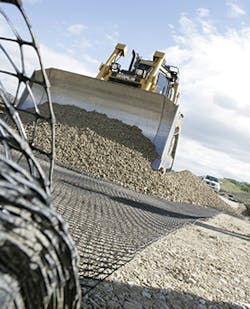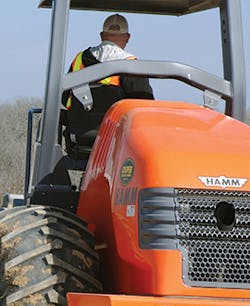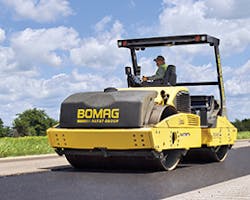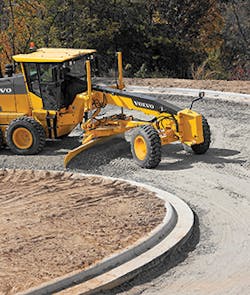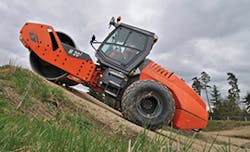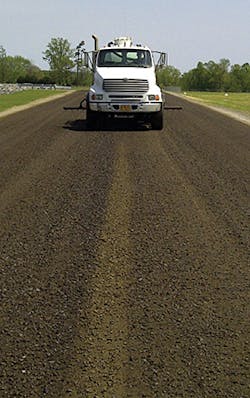To begin with, the sub-base should be some type of compactable material that would produce at least a 95% Proctor compaction test, points out Brian Whitaker, P.E., technical manager of geosynthetics for Fiberweb.
The Proctor compaction test is a method of determining the optimal moisture content at which a soil type will become most dense and achieve maximum dry density.
In preparing a road base, contractors looks for consistency in the material they’re trying to compact, points out Tim Kowalski, the Hamm applications support manager for Wirtgen America.
“If the material changes in any way or manner, they are probably going to have to run more than one Proctor to find out what the moisture content is,” he adds.
Hamm manufacturers various-sized rollers from pad foot to smooth drum, as well as one that offers vibration and oscillation.
“You can initially do the compaction with vibration and then finish up with oscillation to reduce the amount of water pumping to the surface,” notes Kowalski.
Contractors always should consider the need for “good, hard compactable soils,” says Whitaker.
Road defects are usually soft spots that have to be removed and replaced, says Kowalski.
“Trying to compact them more and more is just going to make it worse, so lots of monitoring for consistent material with the proper moisture content is needed,” he adds.
Drainage is always a key factor in building a road, Kowalski points out, adding that if there are areas where water can’t drain off and is instead sitting, a contractor will have a difficult time obtaining the needed compaction.
The geosynthetic material used depends on the stability of material with which a contractor is working, says Kowalski.
“If it’s not very stable, they’ll put in some kind of polymer grid form to stabilize the material so it doesn’t slope, slide off, or lose its consistency,” he says.
Strata’s engineering department recommended a combination of StrataBase and StrataWeb. StrataBase is a rigid biaxial geogrid providing structural reinforcement for roads and parking areas. StrataWeb is a three-dimensional honeycomb geocell providing soil confinement throughout the full depth of the product.
In tandem, the products are designed to provide a stiff base course to withstand heavy loads without significant deformation. StrataBase provides sub-grade stabilization, spreading the weight of the heavy load over a large area, while StrataWeb provides confinement of the compacted base course, preventing future displacement and base course disturbance common with turning of loaded tractor-trailer trucks.
Whitaker points out there are different methods for testing the road after the aggregate gets laid in order to ensure a durable result.
“What we’ve seen is by using a nonwoven geotextile-causing that separation piece and the filtration piece-you elongate the life of a road and the life of pavement,” he says. “For a very small amount of money, you can elongate the life of these infrastructures that are being installed.”
A nonwoven geotextile, such as manufactured by Fiberweb and other companies, goes in between the sub-base and aggregate that is put within the road.
“It helps to separate these two layers in order to prevent what many contractors call “˜pumping’-the aggregate intermingles and mixes with the sub-bases and starts to cause pot-holing and asphalt deterioration,” says Whitaker. “A non-woven geotextile provides a separation and still allows water to permeate back and forth between the sub-base and the aggregate without causing any damage.”
When it comes to base material, Kowalski says, “we seem to lack the amount of testing before we put anything up on the surface. It seems we put everything on top before we do the testing. Unless you have a good base, you’re not going to get the good compaction and consistency up on top.”
As a general rule, double-drum rollers are most effective on asphalt.
While geosynthetics will provide a proper road base preparation and compaction, equipment and machine control will also help ensure a superior roadbed.
According to Volvo, factors influencing equipment choice include total volume to be moved, material type (excavation class, density, water content, cohesiveness), excavation method (excavator, shovel, loader, need for blasting or hammer), transport method (hauler, rigid truck, on-road truck, scraper, conveyor, dozer), dumping method (in layers, into a crusher, over an edge), placement method (compact in layers, need for ground stabilization), project program (duration, key deadlines, critical path activities), project constraints (need to utilize existing fleet, production targets, the decision to buy, rent, or lease), transport distance (haul road, loading and dumping areas), terrain (gradients, curves, ground conditions), weather, and market tradition.
Stephane Machin, building and utility segment leader for Volvo Construction Equipment, outlines the steps taken to perform mass excavation-the removal of a large amount of top soil, dirt, clay, sand, or waste rocks from a job site-in order to get it in a desired condition for road construction, among other projects.
On most projects, ground conditions range from soft to hard, Machin points out. “In the desert, excavation has to be done with one large excavator, and other machines have to make a second pass to move the sand further away to avoid it floating back into the part being excavated,” he says.
The cut-and-fill method used in hard conditions optimizes the level and gradients on roads and should be examined by geo-experts, Machin says.
“Ideally, the cut material volume should match the compacted fill volume,” he adds. “Different machines can be used, depending on the nature of the material and transportation distances.”
Each part of the process-digging, loading, transporting, dozing, grading, and compacting-should be considered in order to optimize the overall process. The soil type will determine the attachments necessary to accomplish the task in the most productive way.
Soil grains are separated by size into four classifications. Soil types are grouped according to their firmness and deformation properties.
Cohesive soils include silt, which exhibits considerable plasticity and cohesion, and clay, sludge, and mud.
Noncohesive soil includes gravel, which has a rounded shape with no tendency to stick together when wet, and sand, which exhibits considerable variations between the grains and can be easily separated by shaking when dry.
Contractors must look at a machine configuration and understand density of material and material conditions, working conditions, and the sizes of the trucks a machine will be loading, Machin says, adding that digging conditions and mobility are the primary factors to consider for general productivity.
The task for the hydraulic excavator is mass excavation, with large amounts of earth excavated and loaded into trucks to be hauled away. Excavators are common in mass excavation because most of the time it requires digging below grade of material, whereas a wheel loader works above grade with a much wider bucket.
A major performance driver is machine configuration (boom and arm, bucket size, track shoe width, and counterweight). Digging performance considerations include break-out and tear-out forces; speed, boom down speed and two-pump flow for bucket, resulting in faster cycle times and higher productivity; five working modes to select the right mode and efficiency for the application at hand, and dumping height and digging depth.
This Volvo motorgrader brings
performance and precision to the job site.
In choosing attachments, the selection of bucket size and type is key to increasing productivity for a higher fill factor and slightly faster cycle time. The bucket size has to be balanced with digging performance. The choice of teeth is also related to digging performance.
Characteristics entailed in using a wheel loader include side loading, with the wheel loader and truck typically on the same level; equipment size dependent on production needs; high demand on production and reliability; specification to be correct for conditions; and a road/floor of variable quality.
In sizing a wheel loader to match a truck fleet, one should consider truck loading height, maneuvering space, and bucket type and size. For use with sand, gravel or blasted rock, it can be beneficial to use wheel loaders, which offer advantages in mobility. They also are ideal for short haul and tight areas, and the buckets are designed to handle a wide range of material types.
Positioning an excavator on a bench above an articulated truck will facilitate faster, easier loading with a goal of maximizing total cycle time. The trick is to match the bucket capacity to the truck capacity so you can load in three to four passes, says Machin.
Loading in mass excavation in under three passes means an oversized bucket in proportion to the truck it is loading, adding more wear and tear on the truck. Under-sizing the excavator in excess of six passes per truck can result in long-term loss of productivity due to increased total cycle time, he adds.
In geotechnical engineering, bearing capacity is the capacity of soil to support the loads applied to the ground and not produce shear failure in the soil.
After the mass excavation is done, the ground will have to be compacted, dozed, and graded. Compaction is achieved by “stirring” or vibrating the soil, causing the trapped grains to loosen and fall down into the cavities. The best results are achieved through a combination of vibration and pressure, Machin says.
Any road is essentially a laminate, points out Jon Sjoblad, who handles marketing communications for Caterpillar Paving Products.
“You’re putting down multiple layers upon layers and this laminate adds strength and flexibility to the whole structure and also provides it with some sort of resistance to weather, which are two of the primary goals of any road,” he says. “The fabric is used in less than ideal engineering characteristics from a soil material or there are drainage issues or other types of erosion issues where it’s too expensive to bring in ideal engineering aggregate or it’s just advantageous to use this geo material to solve the problem.”
Once the preliminary earthworks have been created, the scrapers have gone through, and the dozers have leveled it all off to where there is a stripped-down sub-base, at that point there is an assessment made of the sub-base to determine if the soil needs improvement, says Sjoblad.
“One of the ways you can improve it is add soil cement or some sort of binder, or, if you have heavy clays, you can add lime or something like that to improve the suitability of the soil for being used in a foundation,” he says.
“From that point on, you’re trying to add the best aggregate you can afford to put in, and sometimes that’s using what’s nearby, which may not be completely suitable, but it could be something where you have good aggregate available and your laying that down that doesn’t require a lot of treatment,” says Sjoblad.
To treat the sub-base, a rotary mixer, also known as a reclaimer or a stabilizer, is used.
“This machine, the RM500, is like a giant rototiller. It will crawl along and till up the soil, and at that point you can introduce dry material like lime that you spread in front of it, and it will introduce the water to allow it to cure through an in-board spray system,” says Sjoblad.
“You pre-treat all of this less-than-ideal material to improve its engineering capability and its ability to support the layers above it and the load it will eventually carry.”
After a suitable sub-base is established, the base layer is put down.
“These are progressive layers from large to small aggregate designed for drainage purposes,” Sjoblad says. “Every road is designed different. Some of that is based on what is locally available for aggregate because it’s becoming more expensive to haul in ideal aggregate and it’s often a lot cheaper to just deal with what you’ve got and figure out how to do.”
That’s where geotextiles and any type of soil remediation come into play, he adds.
“The layers you put down are subsequently using smaller and smaller aggregate as you go up and that can be spread,” Sjoblad says. “If it’s something that is hauled in, you’re using a CT660 truck or possibly even a larger one depending on the size of the project.”
A larger highway job may call for the use of an articulated truck, he adds.
“You lay the aggregate down as near as possible to allow whatever is coming behind you,” Sjoblad says. “You might use a motor grader to spread the material on an even layer. Each layer is then compacted.
“If it’s something with a little bit of clay to it, it’s probably going to be a pad foot. If it’s more granular material-which is generally what gets laid because it has better drainage properties-you use something like a smooth drum vibratory compactor. They have varying weights, depending on how thick the layer is and the productivity goals.”
Once the contractor reaches the top of the soil layers, the size of the road will dictate how thick and how many layers there are, Sjoblad says.
“At the top, you’re laying a binder course or putting down tack, which is an asphalt spray designed to help create a bond between asphalt courses and aggregate courses. On top of that is a binder course or a leveling course. You’re taking that finished grade you’ve created on your base layers, creating as near to a flat or smooth surface as you can, and filling in any gaps using a wheeled or tracked asphalt paver to do that,” he says.
The AP1055E mobile track series is favored in North America for its ease of use and performance, says Sjoblad.
Once the mat is down, there is a balancing act between time and heat, he says.
“The aggregate comes from a plant,” says Sjoblad. “Typically they’ll have a mobile plant set up somewhere to make the asphalt mix nearby wherever it is they’re working. As they progressively go past that to a certain degree, they’ll set up a new plant down the road.
“The idea is that asphalt has a shelf life from the minute it’s made and it comes out of the plant at a certain temperature-somewhere between about 300 and 250 degrees for hot mix asphalt-and you have a limited amount of time you have to put that down. As you’re transporting it in your truck from the plant to the paver, you’re losing heat.”
As the heat dissipates, the contractor tries to lay it down as quickly as possible because the asphalt compactor that comes behind the screed of the paver has a limited amount of time it can work on break-down phase, which is where one gets the most of the compaction for the asphalt road service, Sjoblad says.
“It comes out of the paver at 75 to 85% compact to spec. You want to get the compactor in the breakdown phase up in the 90s somewhere,” he says. “There is a zone of heat called the tender zone and it’s creeping up behind you as the mat cools a little bit. You have to work on it before this range of temperature hits and when that particular range hits and it’s different for different mixes and aggregate sizes, you have to get off the mat or otherwise you risk damaging the mat.”
For example, damage can occur through fracturing the aggregate, which will affect the longevity of the road and the smoothness of the ride.
“Once the tender zone passes, then you can get on there and do some intermediate compaction and finish up with a final pass to smooth it out,” he adds.
Generally speaking, double drums are for asphalt. Single drums and vibratory soil compactors are for soil, and pneumatics can be used on either one, Sjoblad says.
A double drum is used on breakdown and intermediate compaction, Sjoblad says. Double drums vary in size and have front and back vibratory drums.
“The vibrations jostle around all of the particles of what you’re compacting, allowing them to realign themselves and naturally seek positions that are denser,” he says.
Pneumatic tire compactors provide a different type of compaction action akin to a kneading process and manipulate the material. It can be used on asphalt or soil, says Sjoblad. “They seal the surface up really well, which helps with keeping it weather-tight.”
Obtaining the ideal density comes through a Proctor test of the maximum dry density of a soil.
“There’s moisture content in that soil that makes it ideal for compaction and you’re trying to discover the ideal quantity of water,” says Sjoblad. “You try to compact this stuff to meet the spec based on that benchmark that if the moisture is perfect, this is how compact this can get.”
Cat AccuGrade Compaction Control System is used on vibratory soil compactors. There are two different ways of configuring the system to provide the contractor with measurement, essentially as an assessment or prediction of soil compaction.
The first is Compact Meter Value (CMV).
“The vibrating drum on the front of a soil compactor is like a hammer hitting the soil as you go along,” says Sjoblad. “The system puts an accelerometer on the drum, and it listens for the response of the soil. Anytime you hit something, there’s going to be a reaction, so it’s actually listening for the ring of the soil.”
A clean ring sound denotes that the soil is very dense and very compact; a “thunk” sound indicates otherwise.
“It’s trained to determine whether there is enough ring to meet compaction specification,” says Sjoblad, adding that all products on the market do so, with varying methods and measurements.
Another option is machine drive power (MDP), used on Cat’s new B-Series Vibratory Soil Compactors, designed to mitigate shortcomings of accelerometer-based systems.
MDP does not rely on an accelerometer, but rather measures the amount of soil-rolling resistance and the amount of energy it needs to produce in order to overcome that resistance.
“One of the features of accelerometer-based measurement is that, because you’re striking soil, you’re measuring quite a distance down into the soil,” notes Sjoblad, adding that it can yield results that show something is buried that might affect the strength of the road.
“All kinds of things get found: old tires, railroad ties, tree trunks or branches, clay balls, big boulders-things like that can have a way of eroding from underneath a completed road or transmuting through the road to damage the surface.”
That becomes an ideal time to do excavation to make the sub-base be as free of defects as possible, he says, adding “if you discover there’s a problem after the asphalt is down, it’s an expensive problem to fix.”
MDP, because it’s not striking the soil, offers less susceptibility to variability.
“When you get onto fines, silt, or cohesive materials like clay, these materials have a natural dampening tendency. You’re not really sure what you’re dealing with; this is called variability,” Sjoblad says. “It’s useful on all materials, so it’s got a wider application range than an accelerometer-based system and can also be used on pad foot or smooth drum machines equipped with pad foot shell kits.”
Another element that plays a role in the creation of a superior road is the application of prime coat material to the top of compacted granular road bases.
“These products have been tested and proven to be beneficial to pavement stability and life expectancy,” points out Chuck Johnson, president of PennzSuppress.
“For years, the most commonly used prime coat material was MC-30, a solvent cutback asphalt that releases volatile organic compounds [VOC’s] and creates ground-level ozone that is harmful to the environment,” he adds. “To significantly reduce VOC emissions, the Clean Air Act prompted regulation that limits the use of solvent cutback asphalt as prime coat and suggests the use of water-based emulsions which are relatively pollution free.”
PennzSuppress D has been designed to be a safe, stable, water-based emulsion that contains no VOC solvents and requires no heating.
While water-based asphalt emulsions are readily available, many prime coat substitutes have been found to have shallow penetration potentials, which can reduce effectiveness and cause messy surface tracking, Johnson says.
Johnson says PennzSuppress D is designed to be a safe, stable, water-based emulsion that contains no VOC solvents and requires no heating. Tests show its performance features are comparable to and exceed solvent cutback asphalt, he says, and that it promotes adhesion and strengthens road base surfaces, penetrates deeper than solvent cutback asphalt or water-based emulsion, reduces moisture susceptibility, and migration, and suppresses dust.
Additionally, a gallon of PennzSuppress D covers five times more surface area than a gallon of solvent-cutback asphalt, garnering cost savings, he says.
“It provides road builders the opportunity to use an effective prime coat without compromising air quality,” Johnson adds.To that end, Gee, who is product manager for Tensar International, says his company’s research with the US Army Corps of Engineers and the company’s products focus on four primary objectives for road construction projects: building on a firm foundation, ensuring good drainage, optimizing the pavement section for project requirements, and, after the road is built, maximizing the life of asphalt overlays.
“We believe and the research shows that making sure a road is built on a firm foundation
is the most important piece of making it last,” Gee says. “It’s also the most important piece of minimizing the road’s life cycle costs because it’s much more expensive to fix the bottom of a pavement section than it is to fix its surface.”
To achieve that, Tensar offers TriAx Geogrid, manufactured from a punched polypropylene sheet oriented in multiple, equilateral directions to form a triangular aperture and designed for high radial stiffness throughout the full 360 degrees.
TriAx Geogrid is used for subgrade stabilization and pavement optimization. Subgrade stabilization is accomplished with TriAx Geogrid by mechanically stabilizing aggregate placed over unstable soil, providing a mechanically stabilized layer (MSL), notes Gee.
“That MSL is stiffer than a comparable layer of aggregate only,” Gee adds. “Geogrid locks the aggregate off so that it stays together, allowing you to take full benefit from the compressive strength of the stone.”
Stone is strong in compression, but it’s a granular material and geogrid confines it in a
way that the stiffness of the layer is increased, Gee says.
“That’s important because the American Association of State Highway and Transportation
Officials’ (AASHTO’s) pavement design methodology takes into account the strength of the subgrade in determining the lifespan of the road,”Gee says.
Achieving that is a two-stage process. The first stage is to get the subgrade stabilized to build on a firm foundation and the second stage is taking into account the requirements for the pavement section being constructed and optimizing the section with available technology, Gee says.
To optimize the pavement, TriAx Geogrid is used to increase the coefficient of the layer
within the AASHTO equation.
“We extend the life of the road because the total stiffness of the pavement is higher than it would be if you just use aggregate without the geogrid,” Gee points out. “The concept of the increasing layer coefficient applies, whether you’re talking about geogrid or not. It has a higher layer coefficient than aggregate.
TriAx Geogrid’s multidirectional properties leverage triangular geometry to provide enhanced level of in-plane stiffness.
“If you design your road with more asphalt in relation to aggregate, you’ll get a stiffer pavement, and it will show that it has more life. The geogrid allows you to stiffen the aggregate layer, which is more efficient than just adding asphalt.”
Once a contractor has achieved a stiffened aggregate layer, the overall pavement structure can be modified to achieve the required traffic capacity with the least expensive structure, he adds.
There are several options to optimizing pavement, Gee points out.
“You could create the thinnest possible pavement section to provide the required traffic capacity, or you could leave the pavement section the same, add the geogrid, and dramatically increase the road’s traffic capacity,” he says.
The middle ground: maintaining the same cost as in the original pavement structure that didn’t involve geogrid and removing only enough material from the structure, whether it’s asphalt or aggregate, to pay for the cost of adding the geogrid, Gee says.
“That typically delivers with TriAx Geogrid somewhere in the neighborhood of three times the life for the same cost,” he says. “If you simply add the TriAx and don’t reduce the pavement structure, a typical value would be five or six times the life, but you would be paying more for the pavement.”
The critical factor in terms of pavement optimization is to utilize test data to justify the layer coefficient being used and the trafficking, whether utilizing a geosynthetic product, a geogrid, geotextile, or a chemical stabilization of the aggregate, Gee says.
When it’s new, asphalt is close to impermeable, Gee says.
“But when it weathers and cracks, it becomes more permeable and, as the road ages, water can get into the structure,” he points out. “That’s where it’s important to get the water out of the structure.”
Although the proper design is not tied to any particular product in all cases, he says, in some cases it makes sense to use a geosynthetic that can help drain the road more effectively.
Tensar’s RoaDrain Roadway Drainage System is used for that purpose. The RoaDrain System is a synthetic subsurface drainage layer featuring nonwoven geotextile filters laminated to the top and bottom of a tri-planar geonet core. The RoaDrain System is designed to ensure a void maintaining structure with high compressive strength to resist deformation, with the geotextile material offering separation and filtration of fines and other materials. The RoaDrain product can be placed directly beneath the Portland cement concrete (PCC) surface to remove water rapidly, directly beneath PCC joints and joint repairs, beneath the aggregate base course to shorten the drainage path, and above the subgrade to act as a capillary break over frost-susceptible soils to help eliminate frost heave.
The product is designed to increase flow rate by 500% to quickly remove water and decrease overall drainage time, provide “excellent” drainage as defined by AASHTO (50% water removal from a pavement structure within two hours) to extend pavement life and reduce maintenance costs, and to lower material costs with the reduction of processed structural fill required, among other factors.
“Typical wisdom is that for every inch of asphalt they miss, the reflection of cracks from the underlying old asphalt will be deterred for one year,” says Gee. “A 3-inch thick asphalt overlay would be expected to last three years under typical conditions before the cracks in the underlying asphalt layer reflect to the surface.”
Products such as Tensar’s GlasGrid Pavement Reinforcement System or GlasPave Waterproofing Paving Mat arrest the stresses associated with the propagation of cracks and dissipate the stress so that the cracks don’t reflect to the surface and can extend the life of the overlay, depending on the product used, by three to five times, says Gee.
“Tying all of these concepts together is an overarching concept: You want the failure of your pavement section to occur as high and as close to the surface as possible, because the closer it is to the surface, the easier it is to fix,” Gee points out.
“That’s why we start with building on a firm foundation, then we want to optimize the pavement, and then we focus on the asphalt,” he adds. “If the foundation and the pavement design are done correctly, then you truly have the option to have a perpetual pavement…. As the surface layer of asphalt wears off, you mill it off and replace it with more asphalt. The underlying structure stays intact, and, in the life cycle of the road, that’s the most efficient way to extend the life. The alternative is if you have a failure lower down, you have to rebuild more of the road or the entire structure.”
